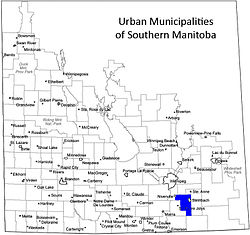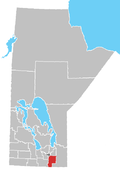Rural Municipality of Hanover
Rural Municipality of Hanover | |
|---|---|
 The Location of the RM of Hanover in southern Manitoba | |
| Coordinates: 49°26′36″N 96°50′57″W / 49.44333°N 96.84917°W | |
| Country | Canada |
| Province | Manitoba |
| Region | Eastman |
| Government | |
| • Reeve | Stan Toews |
| Area | |
| • Total | 741.52 km2 (286.30 sq mi) |
| Elevation | 268 m (879 ft) |
| Population | |
| • Total | 15,733 |
| • Density | 21.2/km2 (55/sq mi) |
| Time zone | UTC-6 (CST) |
| • Summer (DST) | UTC-5 (CDT) |
| Website | http://www.hanovermb.ca/ |
Hanover is a rural municipality (RM) in southeastern Manitoba, Canada. The RM is located southeast of Winnipeg in Division No. 2. It is the fourth most populous municipality in Manitoba (behind the cities of Winnipeg, Brandon, and Steinbach) and most populous RM in the province as of Canada's 2016 census.
History
The area of Hanover was part of the traditional lands of the Ojibway speaking natives. In the summer of 1871, the federal government signed treaties with these people and relocated them to reserves such as the Roseau River Anishinabe First Nation to the south and the Brokenhead Ojibway Nation to the north.[2]
From the lands left behind, the Manitoba government set aside the East Reserve, slightly smaller than what is now the RM of Hanover, for Plautdietsch-speaking Mennonites immigrants from the Russian empire. In 1873, these Mennonites signed an agreement with the Canadian government known as the Privilegium, which guaranteed land, freedom of religion, private schools, and military exemption.[3]
The East Reserve was divided into two municipalities in the early 1880s, as most of the southern Manitoba was organizing itself into new rural municipalities.[3] In 1880, the north part of the East Reserve became the RM of Hespeler, named in honour of William Hespeler, who had brought many of the Mennonite immigrants to the area. The RM of Hanover, to the south, was established on May 25, 1881. The two municipalities shared administrative staff and merged in 1890 to form the single municipality of Hanover.[3]
Other settlers in the area were mainly French and Anglo-Saxons.[3]
Hanover's municipal headquarters were located in the city of Steinbach (originally part of Hanover) until a new office building near Mitchell was constructed in 2001.[4]
Demographics
Hanover has seen steady population growth in recent years and is currently the most populated rural municipality in Manitoba, slightly ahead of the RM of Springfield. It has population of 15,733 as of the Canada 2016 census, which is a 12.2% increase from 2011. The population density of 21.2/km2 is up from 16.0 in 2006.[5][6]
The city of Steinbach and town of Niverville were formerly part of Hanover but are now separate urban municipalities. Steinbach was incorporated in 1946; Niverville in 1969.[7]
Local Urban Districts

Communities
External links
References
- ^ "Population data for Hanover". Statistics Canada. Retrieved February 20, 2017.
- ^ "History and Heritage of Roseau River First Nation". Retrieved 2010-07-01.
- ^ a b c d "RM of Hanover History". RM of Hanover History. Archived from the original on May 30, 2010. Retrieved 2010-07-11.
- ^ "Hanover office officially opens". The Carillon News. 2001-04-05.
- ^ http://www12.statcan.gc.ca/census-recensement/2016/dp-pd/prof/details/page.cfm?Lang=E&Geo1=CSD&Code1=4602041&Geo2=PR&Code2=01&Data=Count&SearchText=Hanover&SearchType=Begins&SearchPR=01&TABID=1&B1=All
- ^ http://www12.statcan.ca/english/census06/data/popdwell/Table.cfm?T=302&SR=101&S=1&O=A&RPP=25&PR=46&CMA=0 Canada 2006 Census
- ^ "The Town Of Niverville Celebrates 50th Anniversary". SteinbachOnline.com. 2019-09-09.

